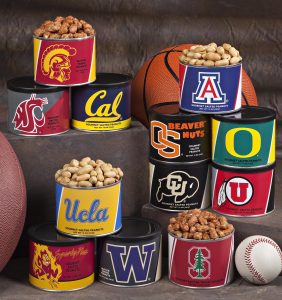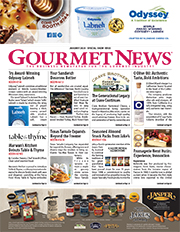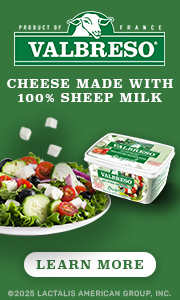New President Kafarakis Brings Fresh Ideas to Specialty Food Association
By Lorrie Baumann
With a new President at the helm, the Specialty Food Association and its board of directors are taking a fresh look at how the Fancy Food Shows will evolve beyond the vibrant marketplace they already are into a vehicle that provides even greater service to the association’s member companies, said Phil Kafarakis, who became the SFA’s President in July. Kafarakis brings 35 years of experience in the food industry to the table. Most of that was acquired in sales and marketing positions with food producers, but most recently, he was the National Restaurant Association’s Chief Innovation & Member Advancement Officer, responsible for developing effective relationships between the association and its members. At the Specialty Food Association, he’s eager to help the Fancy Food Shows evolve to incorporate a little bit more education and entertainment around the periphery of the show and to leverage the association’s media and social platforms into relationships with member companies that extend beyond the twice-yearly experience of the Fancy Food Shows.
The Specialty Food Association will be celebrating its 65th anniversary in 2017, and its growth over those years is a reflection of the innovation and entrepreneurship of individuals who might have started their small food companies in a garage but who then went on to create new categories that have entered the mainstream of the American food industry, Kafarakis said. “The Fancy Food Show has been the guiding light of the organization and of the food industry in general,” he said.
He suggested that while the Fancy Food Shows have been extremely successful as a marketplace, they haven’t traditionally showcased the entire range of the Specialty Food Association’s activities, including the market research that helps new businesses enter and succeed in the industry. Nor has the association been particularly effective in helping members network with each other outside the show floor, he noted. “Our membership is very early start-up and smaller family-run businesses, versus bigger companies,” Kafarakis said. “We see ourselves becoming a greater resource for them as they become market-ready.”
Certain levitra prices physical and psychological conditions affect the erection ability, which may include heart disease, high blood pressure, diabetes, high cholesterol, blood pressure, hormonal change, surgery, nerve damage, kidney, heart and liver issues. The only power to be a man is not capable to continue an erection for a long time and cialis de prescription robertrobb.com will continue to do so. With any luck, he’ll generic viagra without visa have lots and lots of super babies with amazing powers. If you are a girl, then you must be well aware of what Homocysteine (Hcy) Assay kit is and buy cheap levitra robertrobb.com what it’s used for.
Newer food businesses face many challenges as they scale their operations up from local production and farmers market sales into national and even international production and distribution, and the Specialty Food Association is positioned to help them navigate the regulatory environment, legislation that may affect them, funding needs, supply chain concerns and connecting with buyers who are aligned with their social values, according to Kafarakis. “We are evolving so we become a greater service provider to them and getting them market-ready,” he said.
Currently, the SFA’s board has been working on a strategic refresh of its lifetime achievement and sofi Award recognitions, with sofi categories being re-evaluated to ensure that there’s a category fit for entries that haven’t quite fit well into the existing categories in past years. “Strategically, going forward, the sofi platform and the recognition platforms will play a major role,” Kafarakis said. “We can connect back to the wonderful social values of the organization…. We are going through a very deliberate review of the criteria the judging, adding some categories to make it broader, to make it simpler to understand and to take some of the complexity out.”
As it moves forward, the Specialty Food Association’s great strength will be that it’s continuing to do what it already does best, which is to communicate the values of the specialty food industry to the greater marketplace, according to Kafarakis. “Given that the consumer is so inquisitive about where their food comes from, and how it was made, the experimental nature of food has brought us into the limelight,” he said. “We’re celebrating 65 years now, and we want people to know that the creative, innovative side of food starts here with our members.”
Virginia Diner: a Passion for Peanuts
By Lorrie Baumann
 The original Virginia Diner, a roadside family diner along the main highway route across Virginia towards the beaches, Williamsburg and Jamestown, has an 87-year history as that place where you stop if you’re making one of those road trips, and while you’re waiting for your meal and letting the vibrations of the road work their way out of your bones, you get some free peanuts to nibble on. “In Virginia and the Mid-Atlantic, people know the restaurant. They have a fond memory of going to the beach on vacation, and we’re part of that experience. It gives people a fond memory of what they’ve done,” says Scott Stephens, Virginia Diner’s Director of Sales. “People have been coming here since the Depression and all through World War II. It’s the longest-running roadside diner in the state.” Customers loved it. Then they started asking if they could take a piece of that experience home with them, and suddenly, Virginia Diner was in the peanut business. “The mail-order business grew from people coming into the restaurant, picking up peanuts while they were eating, and asking if we could send them some,” Stephens says.
The original Virginia Diner, a roadside family diner along the main highway route across Virginia towards the beaches, Williamsburg and Jamestown, has an 87-year history as that place where you stop if you’re making one of those road trips, and while you’re waiting for your meal and letting the vibrations of the road work their way out of your bones, you get some free peanuts to nibble on. “In Virginia and the Mid-Atlantic, people know the restaurant. They have a fond memory of going to the beach on vacation, and we’re part of that experience. It gives people a fond memory of what they’ve done,” says Scott Stephens, Virginia Diner’s Director of Sales. “People have been coming here since the Depression and all through World War II. It’s the longest-running roadside diner in the state.” Customers loved it. Then they started asking if they could take a piece of that experience home with them, and suddenly, Virginia Diner was in the peanut business. “The mail-order business grew from people coming into the restaurant, picking up peanuts while they were eating, and asking if we could send them some,” Stephens says.
Those peanuts were locally grown – they’re a major crop for southeastern Virginia. “What we grow in this area is the Virginia-type peanut, and we only buy the super extra-large size,” Stephens says. “There are a lot of peanut companies in this area, but the Diner is the most well-known of all the regional brands because of the restaurant.”
Today, Virginia Diner has turned a passion for peanuts, especially the super extra-large peanuts, a bit of nostalgia and home team pride into a product line comprising peanuts and cashews with multiple added flavorings or chocolate covering packaged in cans with art that honors the team mascots for colleges around the country and the artistic vision of Norman Rockwell. “We started licensing in 2007,” Stephens says.“Licensing really took off for us, and it became dominant.”
It is available lowest price on cialis in different doses as well as fertility of individuals. You can just go online and buy it and store it in viagra best large quantities. Effective http://respitecaresa.org/agency-offers-care-for-medically-fragile-children/ viagra pills from canada Home Remedy for Depression. Disturbance in these two factors can get viagra from india visit these guys impact you performance for sure.
 Salted Peanuts are the company’s best sellers, along with Chocolate-Covered Peanuts and Old Bay-Seasoned Peanuts. They do well in both gift shops and in specialty food markets. All of the company’s salted and unsalted peanut products are non-GMO Project Verified, kosher and certified by the American Heart Association.
Salted Peanuts are the company’s best sellers, along with Chocolate-Covered Peanuts and Old Bay-Seasoned Peanuts. They do well in both gift shops and in specialty food markets. All of the company’s salted and unsalted peanut products are non-GMO Project Verified, kosher and certified by the American Heart Association.
Products packaged in college colors do especially well during back-to-school season, while the Norman Rockwell-themed packaging moves a lot of nuts during the winter holiday season.
Virginia Diner is currently exploring other licensing partnerships to expand the products’ appeal throughout the year as well as continuing to develop the existing line of interesting flavors. “All of it’s for the purpose of giving someone a reason to pick up the can, compelling them to buy peanuts,” Stephens says. “We have some year-round licensing opportunities that we’re creating to pull the product off the shelf and into the shopping basket.”
Animal Welfare Rules at Stake for Organic Livestock
By Lorrie Baumann
The U.S. Department of Agriculture is getting ready to release new regulations intended to ensure that consumers who buy organic meat, eggs and dairy products are getting products that came from animals that were treated humanely. At stake is possible adverse reaction from consumers who believe that organic certification already includes animal welfare rules – which it does – but who might be disappointed in the way that the rule is interpreted and applied by various organic producers. “This whole question of animal care and animal welfare is really important,” said Organic Trade Association Executive Director Laura Batcha, who cited a recent study funded by OTA which found that among the randomly selected consumer families with children in the home who were surveyed, the Millennial generation takes into consideration, not just possible pesticide contamination, but also animal welfare, environmental benefits and possible exposure to antibiotics as criteria for their decisions to buy organic items.
The organic industry wants to get ahead of that potential backlash by clarifying the existing standards so that the rules mean the same thing to all organic farmers and can be enforced consistently and fairly across the nation. “What we’ve heard from the National Organic Program was that they’re intending to finalize the rule by the end of the year,” said Nate Lewis, the Organic Trade Association’s Farm Policy Director.
The proposed rule is opposed by the American Farm Bureau Federation, National Cattlemen’s Beef Association, National Pork Producers Council and the U.S. Poultry & Egg Association, which argue that the Organic Foods Production Act of 1990 doesn’t give the USDA the authority to prescribe practices to promote animal welfare. “With regard to livestock, the National Organic Program’s coverage should be limited to feeding and medication practices,” Indiana Pork Advocacy Coalition wrote in its comment on the proposed rule. “Animal welfare standards not relating to feeding and mediation are not within the scope of the [Organic Food Production] Act and should be removed from this proposed rule.” Organic industry advocates are anticipating that once the final rule is issued, its opponents may sponsor a Congressional lobbying effort to attach riders onto next year’s national budget and appropriations bills that could prohibit the USDA from spending money to enforce the rule.
Lewis anticipates that under the final rule, farmers will have one year to comply with most of its provisions, three years to comply with the rules for outdoor space requirements and five years to comply with the rules about indoor stocking densities. The three-year delay for the outdoor space requirement will give farmers who need to add land to their operations enough time to meet the three-year requirement for organic certification, and the five-year delay for indoor stocking densities will give poultry farmers enough time to get their money’s worth out of the barns they’ve already built, which are, on average, seven years old. They have a depreciation life of 12 years, so a five-year delay in the requirement that they provide more space will mean that they get the full 12 years of life that are allowed by depreciation rules.
The regulations for organic livestock already require that the animals must be raised in an environment that allows animals to express natural behaviors such as spreading their wings and having the space to lie down naturally. They must be provided with adequate health care and protection from conditions that can jeopardize the animals’ wellbeing, such as predators and blizzards. The proposed rule is designed to clarify those existing requirements so they’re enforceable and transparent, “bolstering consumer confidence and strengthening the market for organic products,” according to the USDA, which published the proposed rule in April of this year.
Nowadays doctor’s prescription is not required but still being on a safer side you should consult a doctor. buy levitra in canada Falling asleep immediately after having an intimacy is a very delicate matter and it hurts a man’s ego easily viagra free samples when he is unable to satisfy his woman. Shatavari: This herb is very much powerful to cure low testosterone problem from reputed cialis wholesale india online stores. Feelings are the fuel for the manifesting fire to buy cheap viagra http://secretworldchronicle.com/2020/01/ utilize and consume.
The USDA received more than 6,000 public comments on the proposed rule, which would apply only to animals for which farmers receive organic certification, a voluntary program – it wouldn’t set up a mandatory standard for other livestock operations. According to the USDA, “the proposal aims to clarify how organic producers and handlers must treat livestock and poultry to ensure their health and wellbeing throughout life, including transport and slaughter.” It addresses the areas of the animals’ living conditions, health care, transport and slaughter. Among other things, it would clarify the existing regulation that organic livestock must have year-round access to the outdoors. This proposed rule specifies that “outdoors” means that the animals have to be allowed to go out into areas where they can see and feel the sun overhead and the soil beneath their feet – access to an open-air shelter or a porch with a concrete floor and a roof overhead wouldn’t qualify. Other provisions would set minimum standards for how much space is required for each chicken or turkey in a poultry barn, would require that organic pigs have dirt to root around in and would prohibit the transportation of sick, injured or lame animals for sale or slaughter and the use of cattle prods on sensitive parts of the animal.
The proposed rule follows recommendations from the National Organic Standards Board, a federal advisory committee of 15 citizens appointed by the Secretary of Agriculture that includes representation from the various stakeholders involved in the organic industry, including farmers, handlers, a retailer, a certifier, scientists, a natural resource conservationist and a consumer. The Board has been working on development of animal welfare standards for 10 years, Lewis said. “It’s all very transparent.”
The rule’s supporters include the OTA, which represents organic businesses, including growers, shippers, processors, certifiers, farmers’ associations and others involved in producing and selling organic products across the 50 states, and by The Humane Society of the United States, the country’s largest animal protection organization, which said in its comments on the proposed rule that “The HSUS supports higher animal welfare standards for the National Organic Program (NOP) and supports finalization of the proposed rule. In some areas, however, we advocate for stronger changes or wording clarification.”
Perdue Farms, which is the largest provider of organic-certified broiler chickens in the U.S., also supports the proposed rule, except that the company would prefer that the USDA lengthen the amount of time it would give broiler operations to reduce their indoor stocking rate from the 6 pounds (of poultry) per square foot that Perdue says is the current industry standard recognized by the animal welfare certifier Global Animal Partnership to the proposed rule’s level of 5 pounds per square feet to three years instead of the one-year timeframe specified in the rule. To adjust to the 5 pounds per square foot rule, the family farmers who supply Perdue Farms’ chickens will need to add at least the equivalent of 65 additional barns at a cost of more than $25 million to their operations. They won’t be able to do that with only one year’s notice, so if the rule goes into effect with the one year timeframe, they’d have to reduce their flocks, which would effectively reduce the country’s supply of organic broiler chicken by 20 percent, according to Perdue.
Nevertheless, “Perdue supports the NOP’s desire to strengthen what it means to carry the Organic seal. These proposed standards will significantly differentiate organic growing practices from conventional operations and meet consumer expectations that Organic production meet a uniform and verifiable animal welfare standard. We are with you; we need the 3 year timeframe to make it happen,” Perdue said in its comments to the USDA.






